
Wang Kang makes an engraved printing block at the Jinling Scriptural Press in Nanjing, east China's Jiangsu Province, April 19, 2022. Born in 1992, Wang Kang is the eighth generation inheritor of the Jinling Buddhist Scripture Printing, a Chinese engraved block printing technique.
During his ten years with the Nanjing-based Jinling Scriptural Press, which was founded in 1866, Wang has been involved in the design of printing blocks for over 20 classical works containing nearly 100,000 Chinese characters. Often, Wang would describe the completion of a new printing block as witnessing the birth of a new baby.
According to Wang, engraved block printing, like all forms of art, is a legacy of ancient wisdom in one sense, but it also bears the marks of the artisans themselves. "I will continue to do what I've chosen to do," Wang says. "True craftsmanship is found in unending devotion." Wang intends to use modern communication channels in the near future to promote this intangible cultural heritage to the general public. (Xinhua/Li Bo)
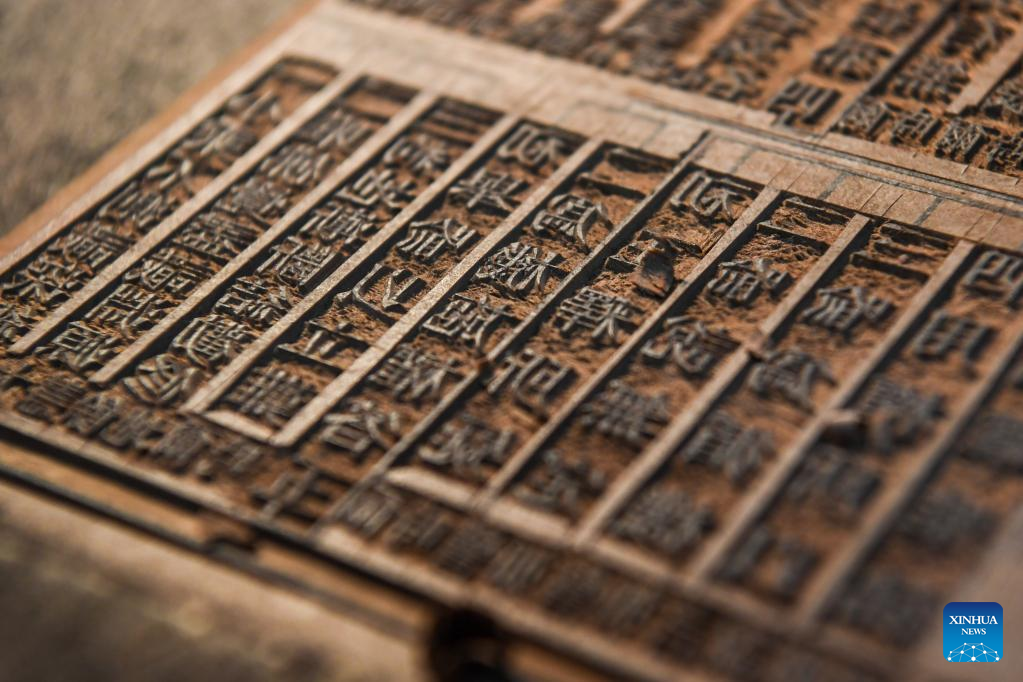
Photo taken on April 15, 2022 shows an engraved printing block Wang Kang is working on at the Jinling Scriptural Press in Nanjing, east China's Jiangsu Province. Born in 1992, Wang Kang is the eighth generation inheritor of the Jinling Buddhist Scripture Printing, a Chinese engraved block printing technique.
During his ten years with the Nanjing-based Jinling Scriptural Press, which was founded in 1866, Wang has been involved in the design of printing blocks for over 20 classical works containing nearly 100,000 Chinese characters. Often, Wang would describe the completion of a new printing block as witnessing the birth of a new baby.
According to Wang, engraved block printing, like all forms of art, is a legacy of ancient wisdom in one sense, but it also bears the marks of the artisans themselves. "I will continue to do what I've chosen to do," Wang says. "True craftsmanship is found in unending devotion." Wang intends to use modern communication channels in the near future to promote this intangible cultural heritage to the general public. (Xinhua/Li Bo)

Wang Kang (L) discusses with his instructor Ma Mengqing at the Jinling Scriptural Press in Nanjing, east China's Jiangsu Province, April 15, 2022. Born in 1992, Wang Kang is the eighth generation inheritor of the Jinling Buddhist Scripture Printing, a Chinese engraved block printing technique.
During his ten years with the Nanjing-based Jinling Scriptural Press, which was founded in 1866, Wang has been involved in the design of printing blocks for over 20 classical works containing nearly 100,000 Chinese characters. Often, Wang would describe the completion of a new printing block as witnessing the birth of a new baby.
According to Wang, engraved block printing, like all forms of art, is a legacy of ancient wisdom in one sense, but it also bears the marks of the artisans themselves. "I will continue to do what I've chosen to do," Wang says. "True craftsmanship is found in unending devotion." Wang intends to use modern communication channels in the near future to promote this intangible cultural heritage to the general public. (Xinhua/Li Bo)
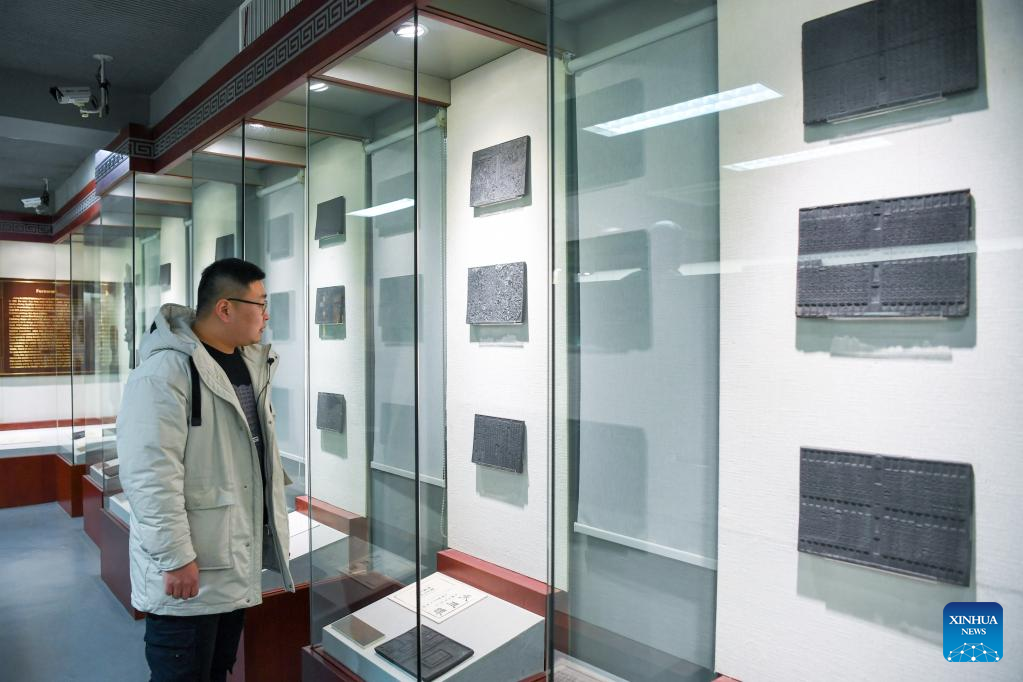
Wang Kang looks at engraved printing blocks exhibited at the Jinling Scriptural Press in Nanjing, east China's Jiangsu Province, Feb. 21, 2022. Born in 1992, Wang Kang is the eighth generation inheritor of the Jinling Buddhist Scripture Printing, a Chinese engraved block printing technique.
During his ten years with the Nanjing-based Jinling Scriptural Press, which was founded in 1866, Wang has been involved in the design of printing blocks for over 20 classical works containing nearly 100,000 Chinese characters. Often, Wang would describe the completion of a new printing block as witnessing the birth of a new baby.
According to Wang, engraved block printing, like all forms of art, is a legacy of ancient wisdom in one sense, but it also bears the marks of the artisans themselves. "I will continue to do what I've chosen to do," Wang says. "True craftsmanship is found in unending devotion." Wang intends to use modern communication channels in the near future to promote this intangible cultural heritage to the general public. (Xinhua/Li Bo)
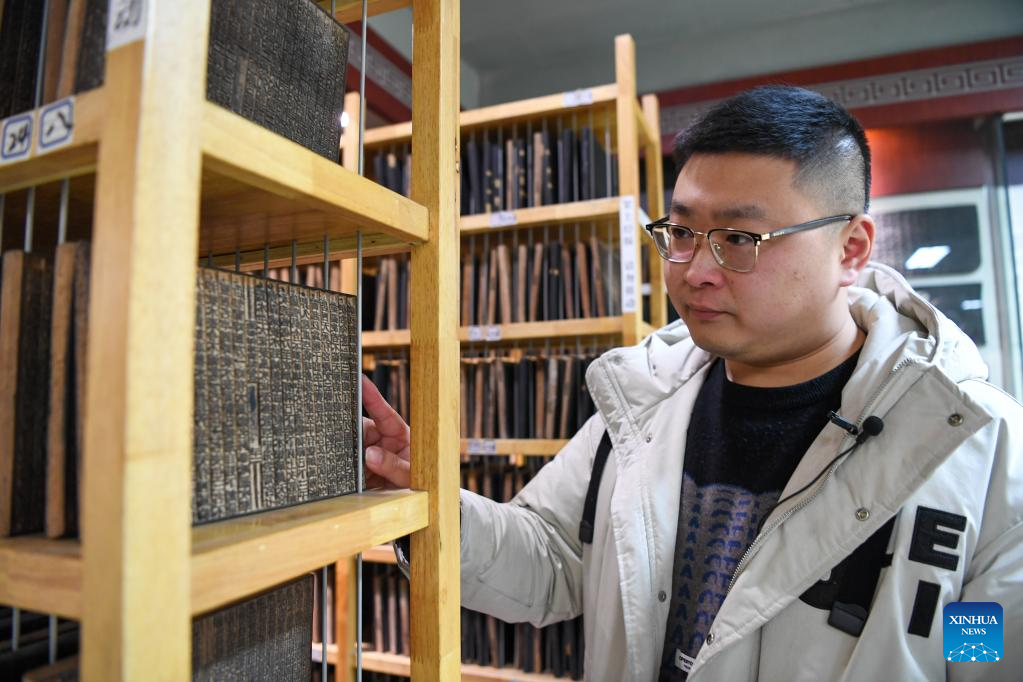
Wang Kang checks engraved printing blocks at the Jinling Scriptural Press in Nanjing, east China's Jiangsu Province, Feb. 21, 2022. Born in 1992, Wang Kang is the eighth generation inheritor of the Jinling Buddhist Scripture Printing, a Chinese engraved block printing technique.
During his ten years with the Nanjing-based Jinling Scriptural Press, which was founded in 1866, Wang has been involved in the design of printing blocks for over 20 classical works containing nearly 100,000 Chinese characters. Often, Wang would describe the completion of a new printing block as witnessing the birth of a new baby.
According to Wang, engraved block printing, like all forms of art, is a legacy of ancient wisdom in one sense, but it also bears the marks of the artisans themselves. "I will continue to do what I've chosen to do," Wang says. "True craftsmanship is found in unending devotion." Wang intends to use modern communication channels in the near future to promote this intangible cultural heritage to the general public. (Xinhua/Li Bo)
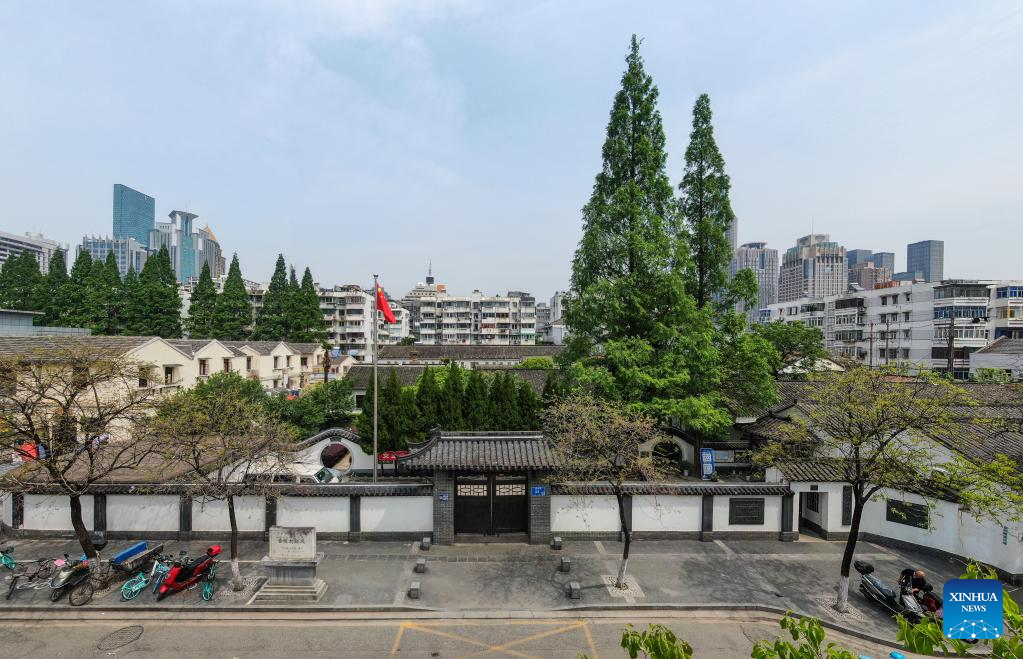
Aerial photo taken on April 20, 2022 shows an exterior view of the Jinling Scriptural Press in Nanjing, east China's Jiangsu Province. Born in 1992, Wang Kang is the eighth generation inheritor of the Jinling Buddhist Scripture Printing, a Chinese engraved block printing technique.
During his ten years with the Nanjing-based Jinling Scriptural Press, which was founded in 1866, Wang has been involved in the design of printing blocks for over 20 classical works containing nearly 100,000 Chinese characters. Often, Wang would describe the completion of a new printing block as witnessing the birth of a new baby.
According to Wang, engraved block printing, like all forms of art, is a legacy of ancient wisdom in one sense, but it also bears the marks of the artisans themselves. "I will continue to do what I've chosen to do," Wang says. "True craftsmanship is found in unending devotion." Wang intends to use modern communication channels in the near future to promote this intangible cultural heritage to the general public. (Xinhua/Li Bo)
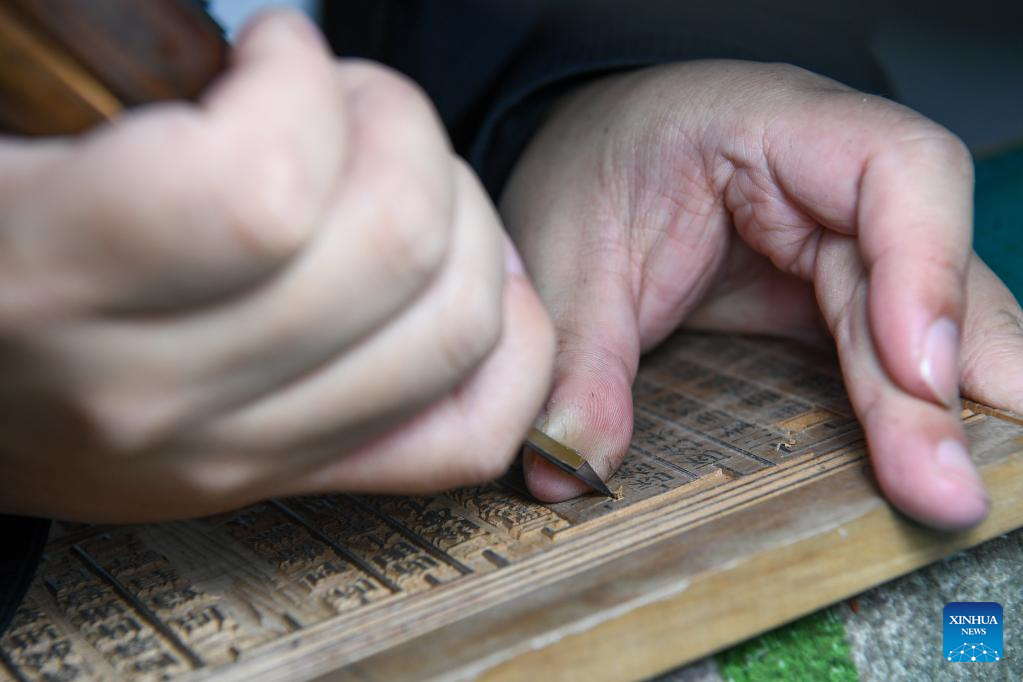
Wang Kang makes an engraved printing block at the Jinling Scriptural Press in Nanjing, east China's Jiangsu Province, April 15, 2022. Born in 1992, Wang Kang is the eighth generation inheritor of the Jinling Buddhist Scripture Printing, a Chinese engraved block printing technique.
During his ten years with the Nanjing-based Jinling Scriptural Press, which was founded in 1866, Wang has been involved in the design of printing blocks for over 20 classical works containing nearly 100,000 Chinese characters. Often, Wang would describe the completion of a new printing block as witnessing the birth of a new baby.
According to Wang, engraved block printing, like all forms of art, is a legacy of ancient wisdom in one sense, but it also bears the marks of the artisans themselves. "I will continue to do what I've chosen to do," Wang says. "True craftsmanship is found in unending devotion." Wang intends to use modern communication channels in the near future to promote this intangible cultural heritage to the general public. (Xinhua/Li Bo)
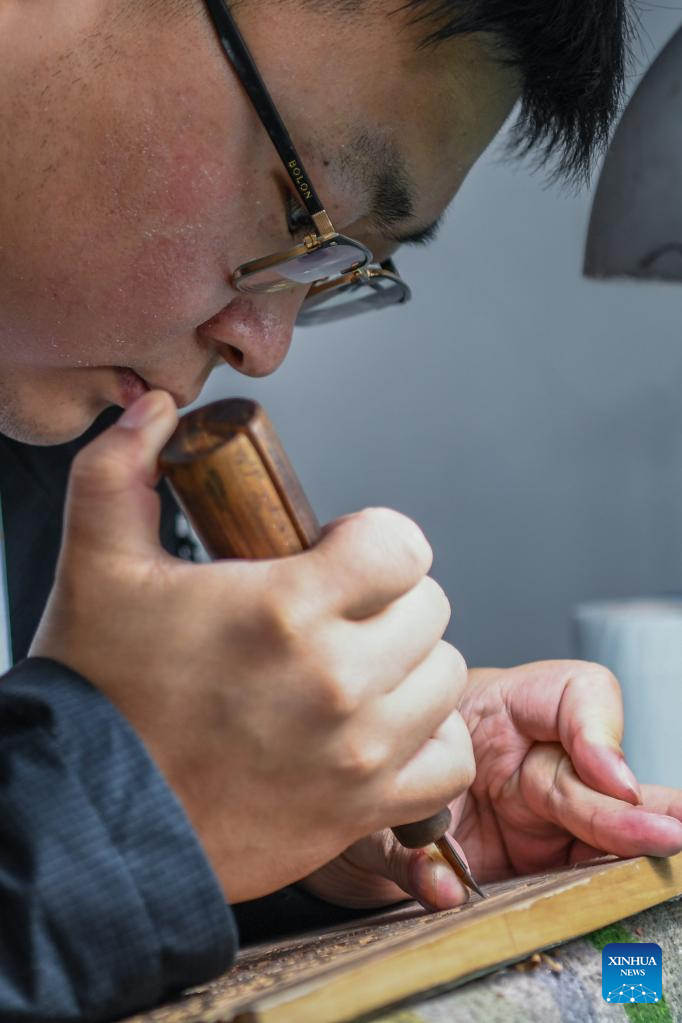
Wang Kang makes an engraved printing block at the Jinling Scriptural Press in Nanjing, east China's Jiangsu Province, April 15, 2022. Born in 1992, Wang Kang is the eighth generation inheritor of the Jinling Buddhist Scripture Printing, a Chinese engraved block printing technique.
During his ten years with the Nanjing-based Jinling Scriptural Press, which was founded in 1866, Wang has been involved in the design of printing blocks for over 20 classical works containing nearly 100,000 Chinese characters. Often, Wang would describe the completion of a new printing block as witnessing the birth of a new baby.
According to Wang, engraved block printing, like all forms of art, is a legacy of ancient wisdom in one sense, but it also bears the marks of the artisans themselves. "I will continue to do what I've chosen to do," Wang says. "True craftsmanship is found in unending devotion." Wang intends to use modern communication channels in the near future to promote this intangible cultural heritage to the general public. (Xinhua/Li Bo)
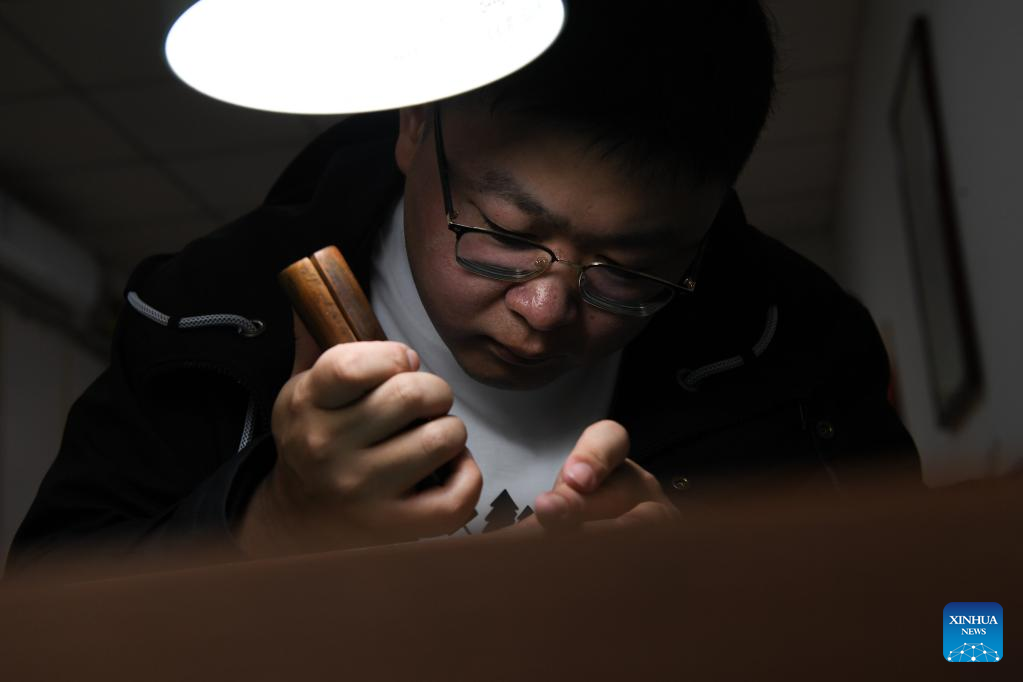
Wang Kang makes an engraved printing block at the Jinling Scriptural Press in Nanjing, east China's Jiangsu Province, April 15, 2022. Born in 1992, Wang Kang is the eighth generation inheritor of the Jinling Buddhist Scripture Printing, a Chinese engraved block printing technique.
During his ten years with the Nanjing-based Jinling Scriptural Press, which was founded in 1866, Wang has been involved in the design of printing blocks for over 20 classical works containing nearly 100,000 Chinese characters. Often, Wang would describe the completion of a new printing block as witnessing the birth of a new baby.
According to Wang, engraved block printing, like all forms of art, is a legacy of ancient wisdom in one sense, but it also bears the marks of the artisans themselves. "I will continue to do what I've chosen to do," Wang says. "True craftsmanship is found in unending devotion." Wang intends to use modern communication channels in the near future to promote this intangible cultural heritage to the general public. (Xinhua/Li Bo)
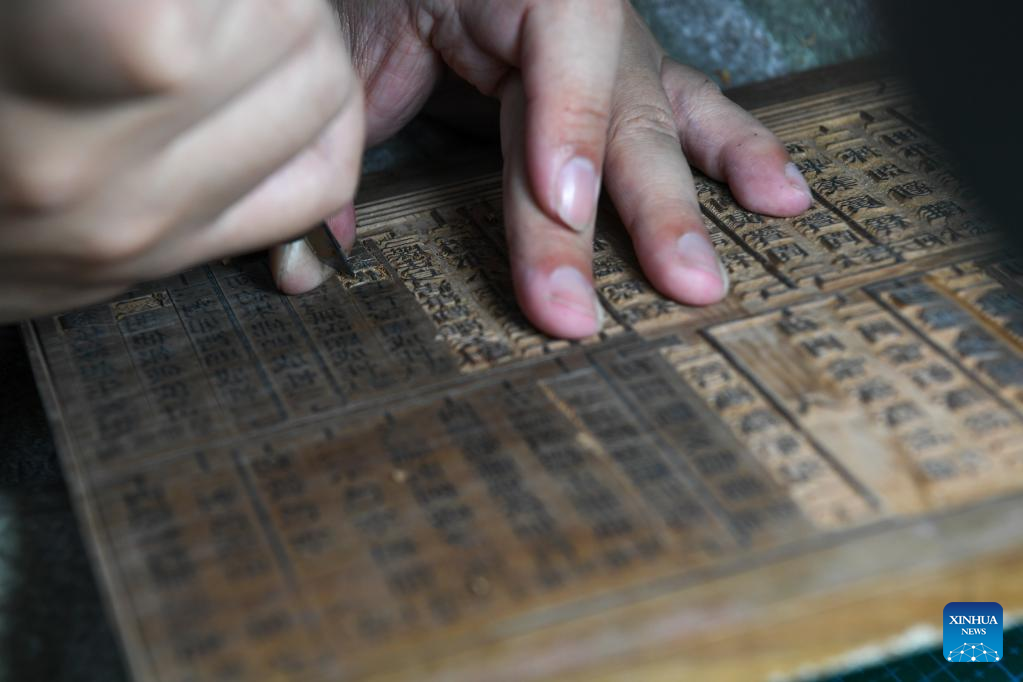
Wang Kang makes an engraved printing block at the Jinling Scriptural Press in Nanjing, east China's Jiangsu Province, April 15, 2022. Born in 1992, Wang Kang is the eighth generation inheritor of the Jinling Buddhist Scripture Printing, a Chinese engraved block printing technique.
During his ten years with the Nanjing-based Jinling Scriptural Press, which was founded in 1866, Wang has been involved in the design of printing blocks for over 20 classical works containing nearly 100,000 Chinese characters. Often, Wang would describe the completion of a new printing block as witnessing the birth of a new baby.
According to Wang, engraved block printing, like all forms of art, is a legacy of ancient wisdom in one sense, but it also bears the marks of the artisans themselves. "I will continue to do what I've chosen to do," Wang says. "True craftsmanship is found in unending devotion." Wang intends to use modern communication channels in the near future to promote this intangible cultural heritage to the general public. (Xinhua/Li Bo)
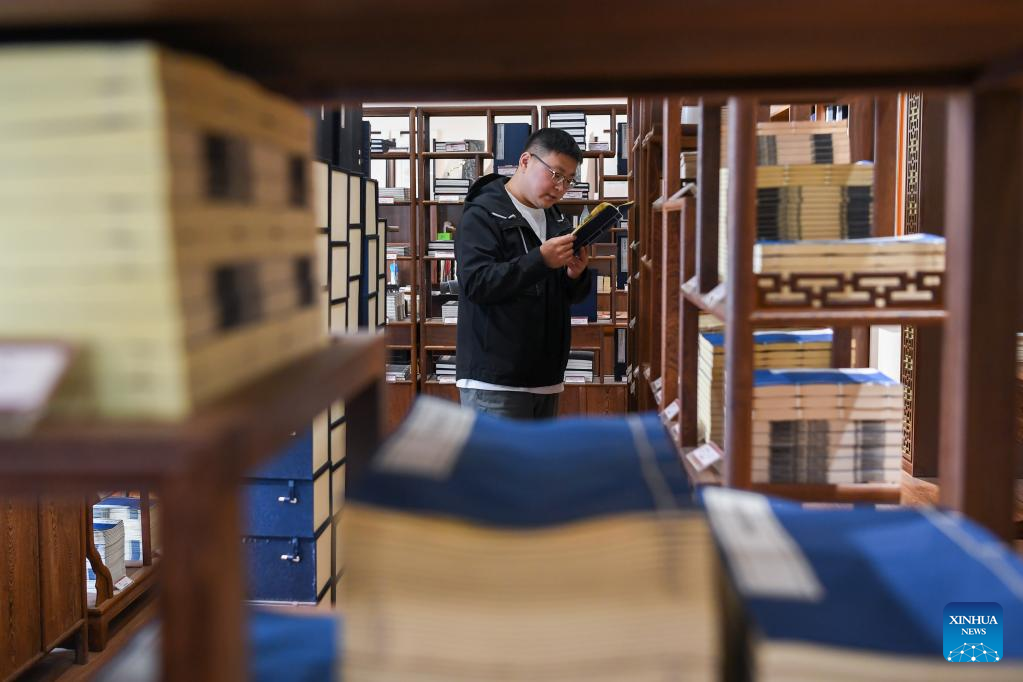
Wang Kang looks for inspirations from ancient books at the Jinling Scriptural Press in Nanjing, east China's Jiangsu Province, April 15, 2022. Born in 1992, Wang Kang is the eighth generation inheritor of the Jinling Buddhist Scripture Printing, a Chinese engraved block printing technique.
During his ten years with the Nanjing-based Jinling Scriptural Press, which was founded in 1866, Wang has been involved in the design of printing blocks for over 20 classical works containing nearly 100,000 Chinese characters. Often, Wang would describe the completion of a new printing block as witnessing the birth of a new baby.
According to Wang, engraved block printing, like all forms of art, is a legacy of ancient wisdom in one sense, but it also bears the marks of the artisans themselves. "I will continue to do what I've chosen to do," Wang says. "True craftsmanship is found in unending devotion." Wang intends to use modern communication channels in the near future to promote this intangible cultural heritage to the general public. (Xinhua/Li Bo)
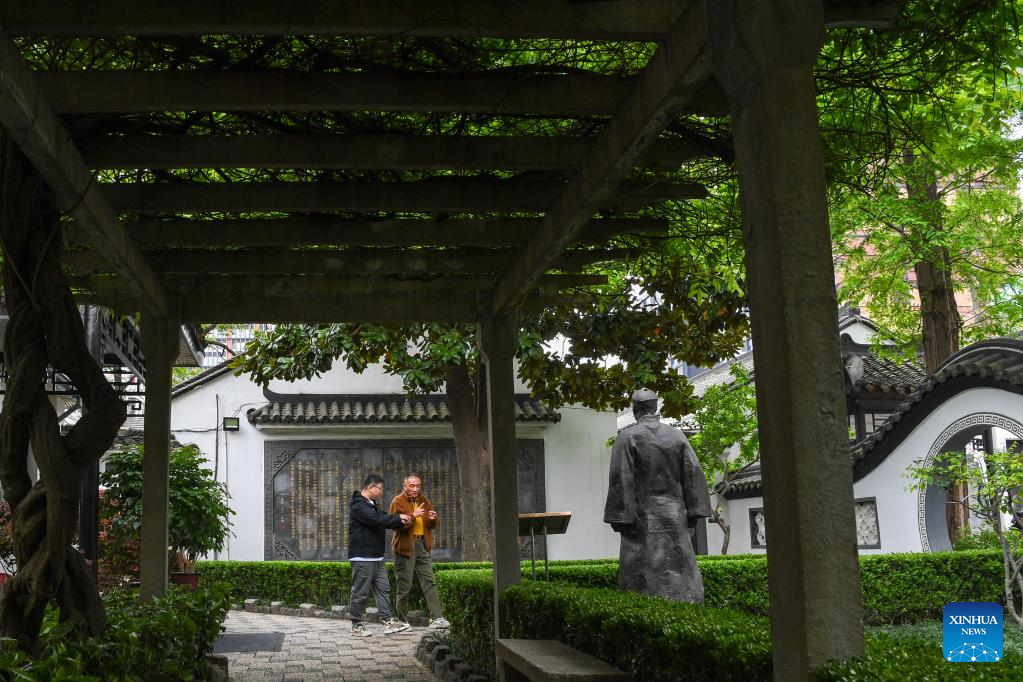
Wang Kang (L) talks with his instructor Ma Mengqing during a walk at the Jinling Scriptural Press in Nanjing, east China's Jiangsu Province, April 15, 2022. Born in 1992, Wang Kang is the eighth generation inheritor of the Jinling Buddhist Scripture Printing, a Chinese engraved block printing technique.
During his ten years with the Nanjing-based Jinling Scriptural Press, which was founded in 1866, Wang has been involved in the design of printing blocks for over 20 classical works containing nearly 100,000 Chinese characters. Often, Wang would describe the completion of a new printing block as witnessing the birth of a new baby.
According to Wang, engraved block printing, like all forms of art, is a legacy of ancient wisdom in one sense, but it also bears the marks of the artisans themselves. "I will continue to do what I've chosen to do," Wang says. "True craftsmanship is found in unending devotion." Wang intends to use modern communication channels in the near future to promote this intangible cultural heritage to the general public. (Xinhua/Li Bo)
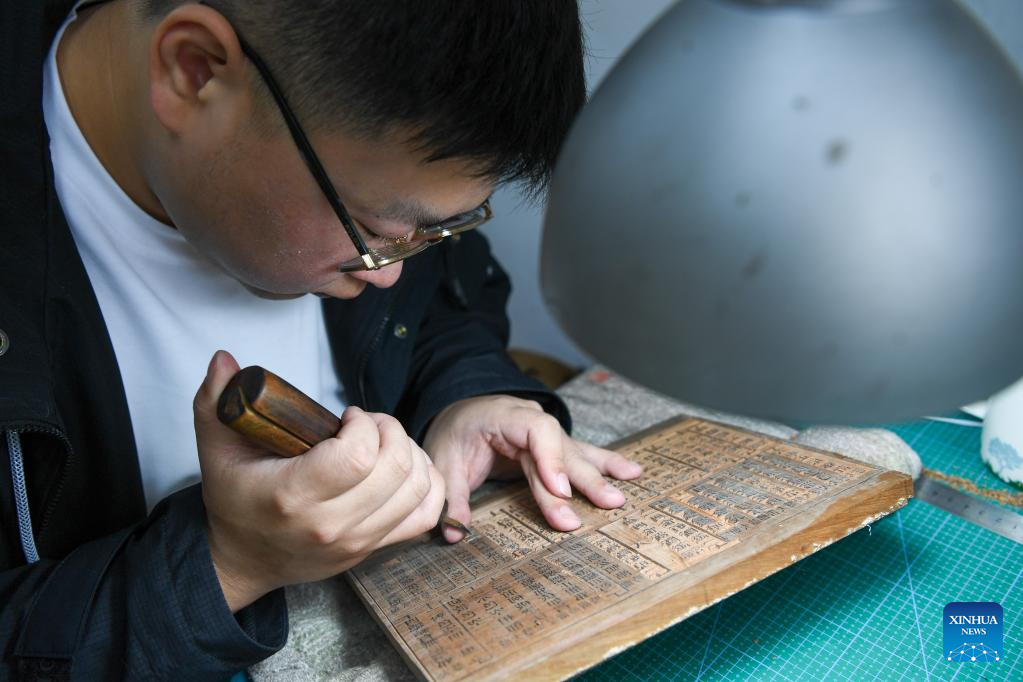
Wang Kang makes an engraved printing block at the Jinling Scriptural Press in Nanjing, east China's Jiangsu Province, April 15, 2022. Born in 1992, Wang Kang is the eighth generation inheritor of the Jinling Buddhist Scripture Printing, a Chinese engraved block printing technique.
During his ten years with the Nanjing-based Jinling Scriptural Press, which was founded in 1866, Wang has been involved in the design of printing blocks for over 20 classical works containing nearly 100,000 Chinese characters. Often, Wang would describe the completion of a new printing block as witnessing the birth of a new baby.
According to Wang, engraved block printing, like all forms of art, is a legacy of ancient wisdom in one sense, but it also bears the marks of the artisans themselves. "I will continue to do what I've chosen to do," Wang says. "True craftsmanship is found in unending devotion." Wang intends to use modern communication channels in the near future to promote this intangible cultural heritage to the general public. (Xinhua/Li Bo)
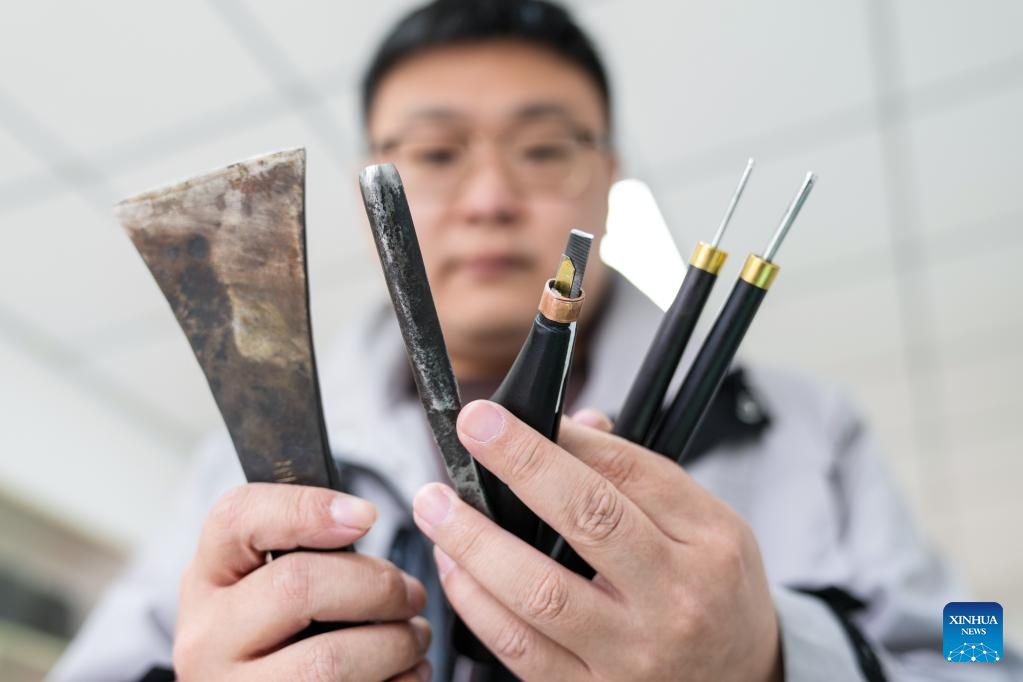
Wang Kang shows carving tools at the Jinling Scriptural Press in Nanjing, east China's Jiangsu Province, April 19, 2022. Born in 1992, Wang Kang is the eighth generation inheritor of the Jinling Buddhist Scripture Printing, a Chinese engraved block printing technique.
During his ten years with the Nanjing-based Jinling Scriptural Press, which was founded in 1866, Wang has been involved in the design of printing blocks for over 20 classical works containing nearly 100,000 Chinese characters. Often, Wang would describe the completion of a new printing block as witnessing the birth of a new baby.
According to Wang, engraved block printing, like all forms of art, is a legacy of ancient wisdom in one sense, but it also bears the marks of the artisans themselves. "I will continue to do what I've chosen to do," Wang says. "True craftsmanship is found in unending devotion." Wang intends to use modern communication channels in the near future to promote this intangible cultural heritage to the general public. (Xinhua/Li Bo)



